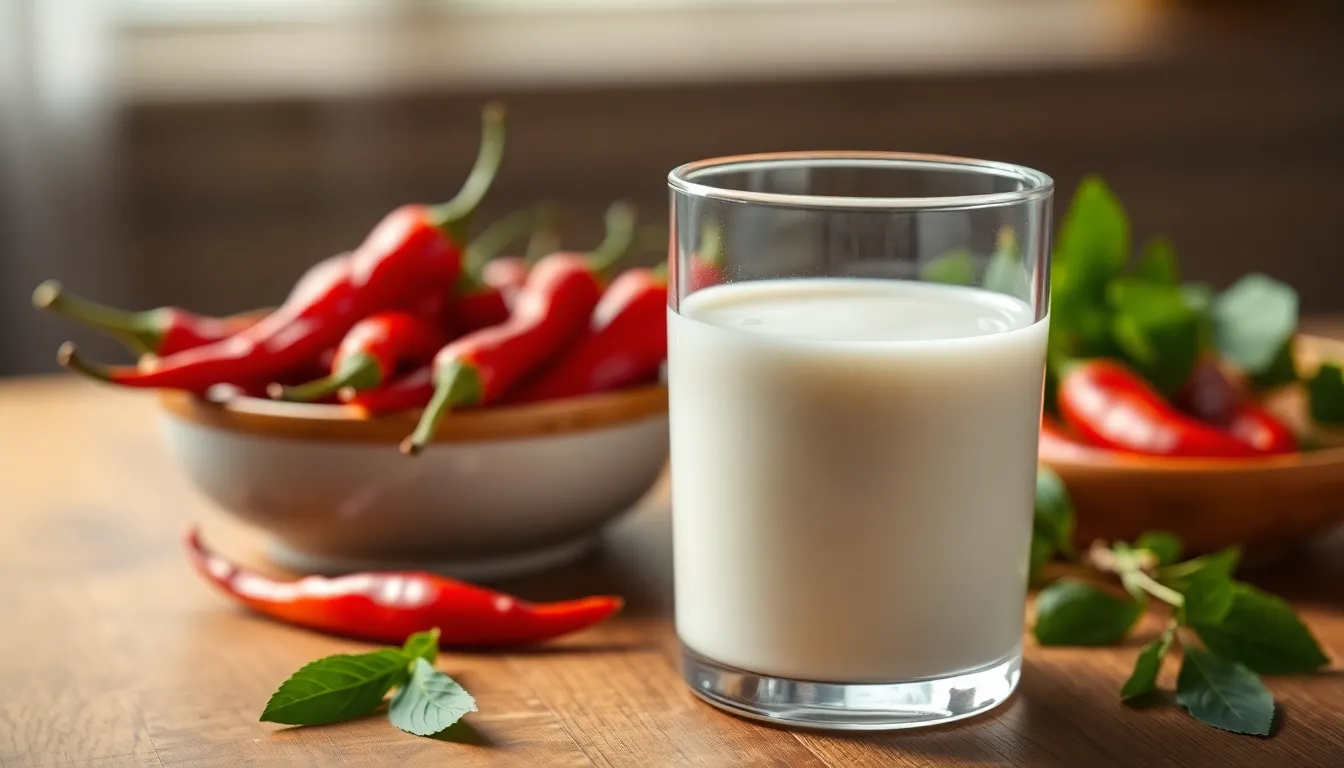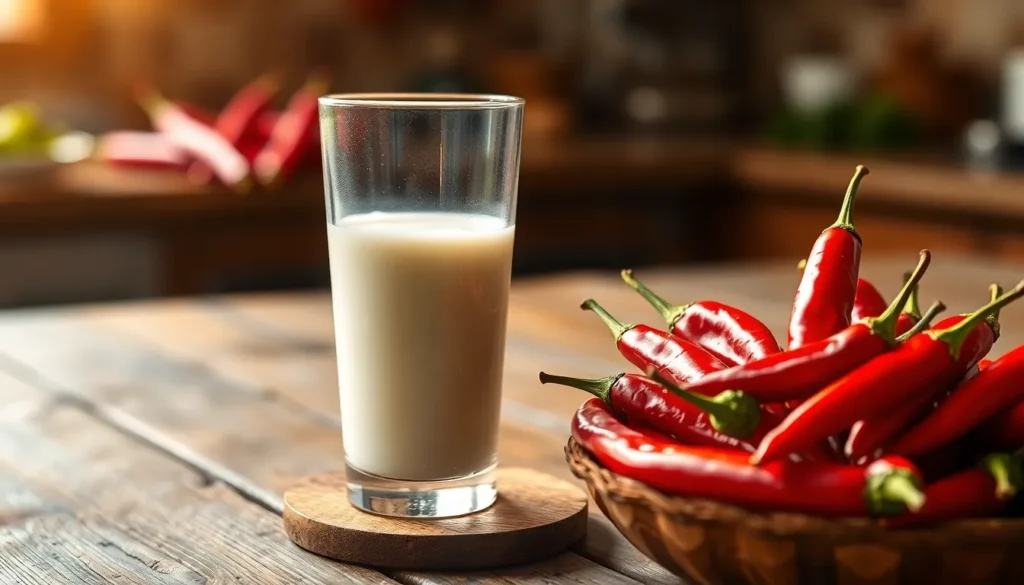Spicy foods can ignite a fiery sensation that leaves many reaching for relief. While water might seem like the obvious choice, it often intensifies the burn instead of soothing it. Enter milk, the creamy hero that provides comfort and relief from the heat. But what makes milk so effective against spice?
The answer lies in its unique composition. Milk contains casein, a protein that binds to capsaicin—the compound responsible for that spicy kick. By doing so, it helps wash away the heat, making it a go-to remedy for spice lovers and culinary adventurers alike. Understanding why milk helps with spice not only enhances the dining experience but also unveils the science behind our taste buds and how they respond to different flavors.
Table of Contents
ToggleUnderstanding Spice and Heat
Spice derives from compounds that create a sensation of heat, primarily capsaicin, found in chili peppers. Capsaicin binds to pain receptors in the mouth, triggering a burning sensation. This interaction influences flavor perception, often enhancing the overall taste experience.
Heat perception varies among individuals. Factors like genetics, experience with spicy foods, and cultural background contribute to differing tolerances. Some enjoy intense heat, while others prefer milder flavors.
Water interacts poorly with capsaicin due to its polar nature. Since capsaicin is non-polar, water fails to dissolve or wash away the heat effectively. This misconception leads many to seek relief with water, resulting in continued discomfort.
Milk, on the other hand, contains the protein casein, which effectively binds with capsaicin. This binding action helps to wash away the burning sensation, providing relief. Additionally, the fat content in milk acts as a buffer, soothing the mucous membranes and enhancing the cooling effect.
Understanding the chemical nature of spice and heat illustrates why milk is an effective remedy for discomfort caused by spicy foods.
The Science Behind Milk

Milk’s unique composition explains its effectiveness in counteracting the effects of spicy foods. The presence of specific components in milk helps alleviate the burning sensation caused by capsaicin.
Composition of Milk
Milk consists of water, fat, protein, lactose, and vitamins. The primary protein in milk, casein, plays an essential role in binding with capsaicin. The fat content in milk further helps to coat the mucous membranes in the mouth, offering additional relief. Whole milk, which contains higher fat levels, may provide greater soothing effects compared to skim or low-fat options.
How Milk Neutralizes Spice
Milk neutralizes spice by forming a bond with capsaicin, effectively washing it away from the pain receptors in the mouth. This interaction occurs because casein molecules encapsulate capsaicin, preventing it from eliciting the burning sensation. Additionally, the fat in milk helps dissolve capsaicin, thus reducing its impact on sensory receptors. Unlike water, which fails to dissolve capsaicin, milk’s combined properties offer significant relief from spicy food discomfort.
Types of Dairy Products
Various dairy products play a significant role in alleviating the burning sensation caused by spicy foods. Understanding the differences among them can enhance one’s dining experience.
Whole Milk vs. Skim Milk
Whole milk contains a higher fat content, typically around 3.25%, which provides superior soothing effects against spiciness. The fat helps dissolve capsaicin more effectively, leading to a greater reduction in the burning sensation. Skim milk, with less than 0.5% fat, lacks the same binding properties and may not offer the same relief. In conclusion, whole milk stands out as the better choice for soothing spicy flavors.
Other Dairy Options
Several dairy alternatives also help mitigate spice. Yogurt, especially full-fat varieties, contains fat and protein that bind with capsaicin and calm the palate. Kefir, a fermented milk drink, offers probiotics along with similar soothing properties. Sour cream, rich in fat, effectively cools down heat when added to spicy dishes. Cheese, particularly creamy options, such as mozzarella or cream cheese, can also provide relief due to their fat content. Each of these dairy products contributes to a less intense spicy experience.
Practical Applications
Understanding how milk alleviates spice opens up various practical applications in cooking and pairing.
Cooking Tips
Incorporating milk-based ingredients in spicy dishes enhances flavor and reduces heat. Use cream, yogurt, or milk in sauces and marinades to temper the heat from chilies. For example, adding sour cream to spicy tacos balances flavors while soothing the palate. Blending pepper sauces with yogurt or dairy cream creates a creamy texture that complements spicy dishes without overwhelming heat. Additionally, consider marinating meats in a milk-based mixture for tenderness and flavor moderation. This technique brings out the natural sweetness in spices, providing a more enjoyable eating experience.
Pairing Suggestions
Pairing spicy dishes with dairy products enhances the overall dining experience. Serve spicy curries with a side of raita, made from yogurt and cucumbers, to cool the palate. Enjoy spicy Mexican foods, like enchiladas, with a dollop of sour cream to balance the heat. Creamy cheeses, such as feta or goat cheese, can also complement spicy salads or salsas. Including milkshakes or smoothies with spices provides a delightful contrast, making meals more enjoyable without sacrificing flavor. Combining spicy foods with appropriate dairy options creates a balanced approach to enjoying bold flavors.
Milk stands out as the go-to remedy for countering the heat from spicy foods. Its unique combination of casein and fat effectively neutralizes capsaicin, providing relief where water falls short. By understanding milk’s role in balancing flavors, individuals can enhance their culinary experiences while enjoying the thrill of spice.
Incorporating dairy products into spicy dishes not only mitigates discomfort but also enriches the overall taste. Whether it’s creamy yogurt in a sauce or a splash of whole milk in a curry, these pairings can transform a fiery meal into a delightful experience. Embracing milk as a companion to spice opens up a world of flavor possibilities, making each bite enjoyable and satisfying.









